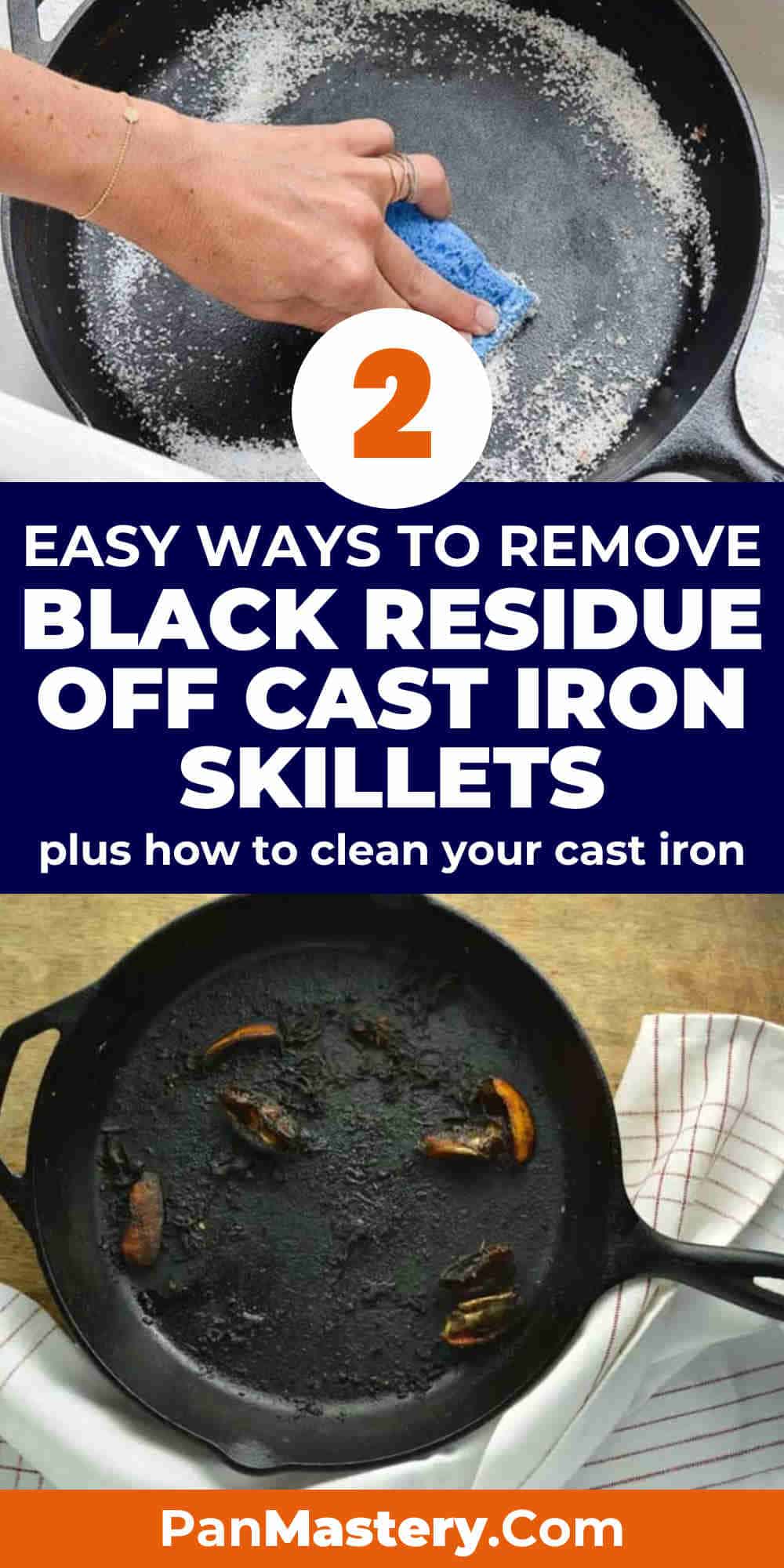
Our kitchenware can collect grime and rust over time. This is especially true when using a cast-iron skillet. In this guide, we will tell you all about how to remove the black residues off your iron skillet. This comprehensive tutorial will provide step-by-step instructions to ensure you will have a spotless pan.
What is a Cast Iron Skillet?
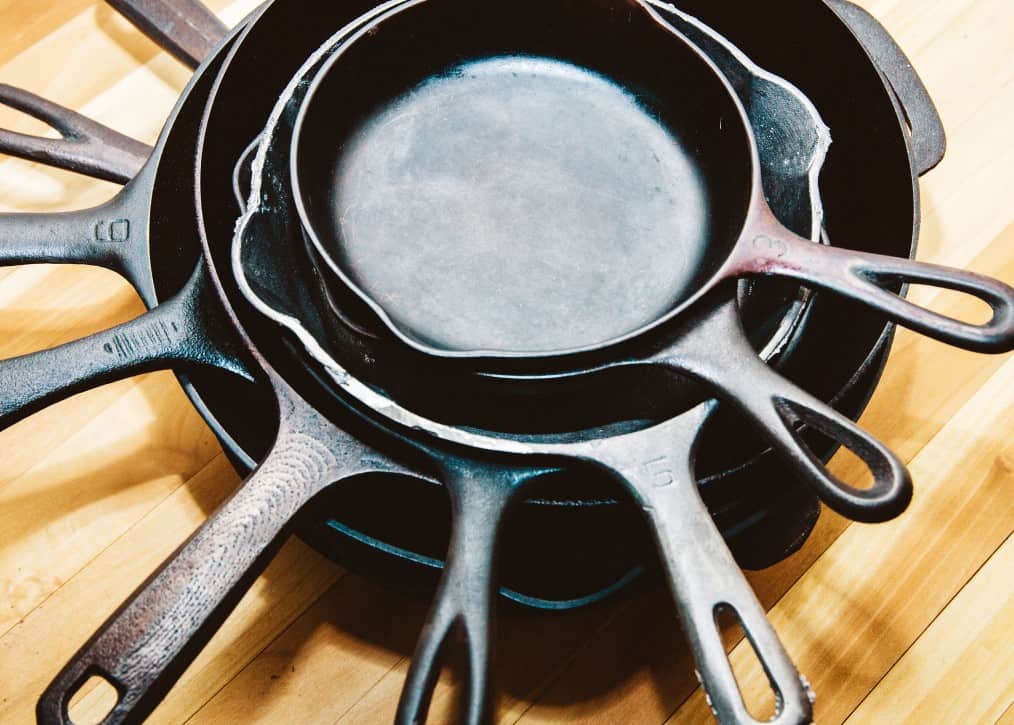
Cast Iron Skillet is a type of cookware made with iron and carbon that is poured directly into a skillet mold. Cast irons are known for their durability. A lot of used cast iron in our modern days is around 25-100 years old. It’s excellent if you want cheap but lasting cookware.
Even if your cast iron is rusted, with the right tools and processes you can restore it and use it, good as new.
However, a few downsides can come with using cast iron. Maintaining and cleaning it comes with a lot of don’ts. Read further as we tell you all about it in this guide.
What is the Black Residue in the Iron Skillet?
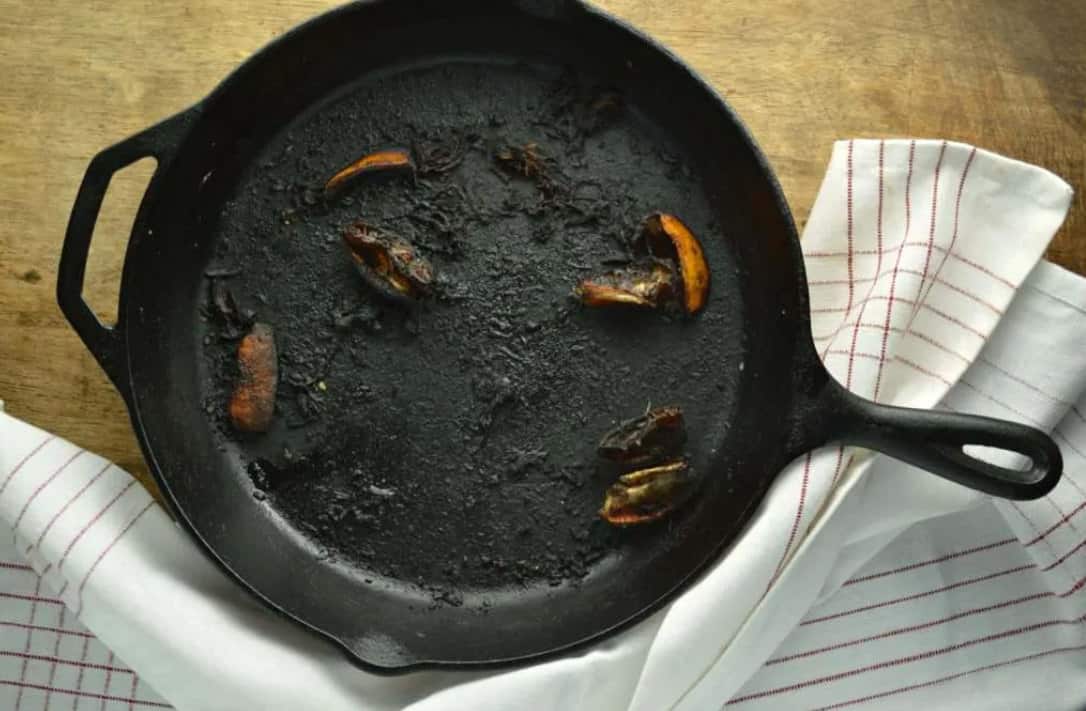
Before knowing how to remove the black stuff on your skillet, it’s important to understand the source of this residue. The black residue on your iron skillet is from the carbon build-up and leftover food caused by heat. This carbon can come from different sources while cooking such as heated oils and fats, burnt coating, and charred leftovers.
If you find this dark debris in your food, you don’t have to worry. The black residues on your iron skillet are not harmful. Since it’s just a build-up from leftover food and oils, ingesting small amounts will not pose a health risk. Although, cooking in a stained skillet can be unsightly for your prepared food.
There are a couple of reasons why this carbon build-up developed as residue:
- The skillet is not washed immediately after use.
- Lack of proper maintenance done to the skillet.
- The skillet is not seasoned regularly.
If you are reading this article, you may be facing the issue of black residue on your skillet. Don’t worry! We will teach you all about how to remove the black residue off your iron skillet. Just follow the easy step-by-step instructions and you will have clean cookware in no time.
2 Ways to Remove Black Residue
Use Salt
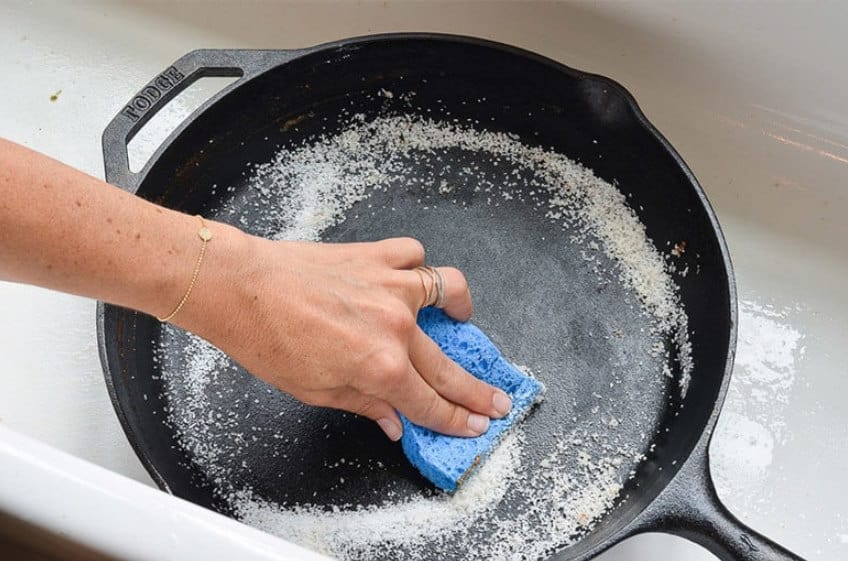
Salt is a staple in the kitchen. Fortunately, it’s also a great product when it comes to cleaning your skillet. It’s abrasive and accessible. To do the salt method you need to:
- Pour 1-2 cups of water into your skillet and bring it to a boil. Let the boiling water simmer for 2-5 minutes before removing. The heat from the boiling water will help in loosening the stuck residue.
- Use a paper towel or a clean dish rag to dry off the cast iron. Be careful not to touch the iron as it’s still hot.
- Once it’s dry, add a quarter to a half cup of salt. Use the paper towel or dish rag to scrub the salt against the iron cast’s surface. The salt will start to have discoloration, meaning that the residue is starting to lift off.
- Wash the skillet with warm water. If there are still residues stuck, put on salt and repeat the process.
- Once you rinse the skillet, dry it off.
- Then, pat down a few drops of either coconut oil, flaxseed oil, or canola oil. The oil will help protect the skillet from black residue. To secure the oil on the pan, you can put your cast iron on a high flame for a minute and let it heat up.
If you want to see this process, you can watch it here.
Brushing Method
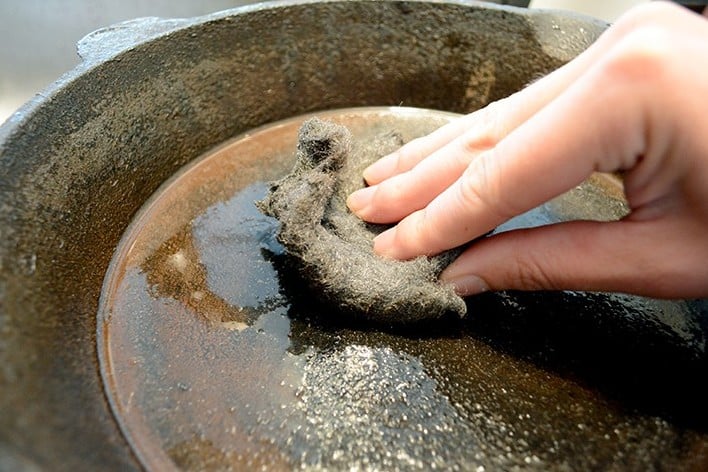
You can brush your cast iron either after using the salt method or by itself. It applies the same principle as using salt. By scrubbing a rough material against the cast iron, you will remove the layer of build-up residue. You can find a brush specially made for cleaning your cast iron skillet.
To do this method you should:
- Pour 1-2 cups of water in your cast iron and let it boil. While it’s boiling, let the simmer for 2-5 minutes then turn off the heat.
- While the water is still in the pan, use the brush to scrub the dark debris. If it’s not coming off, you can use a small amount of dishwashing soap to help with the breaking down of oils and grime. Note that using soap in your iron skillet can rub off the patina or season coating. If you choose to use a soap with the removal of the black residue, make sure to re-season your pan and do it sparingly.
- Once you are done scrubbing, discard the water and rinse off your cast iron.
- Then, grab a paper towel or dish rag to dry off the skillet. Once it’s dry put on oil and you’re done!
Now that you removed the black residue from your cast iron skillet, you should know how to keep it from happening again. Maintenance and regular cleaning is the key to great cookware.
3 Ways to Keep Off the Black Residue from Your Cast Iron Skillet
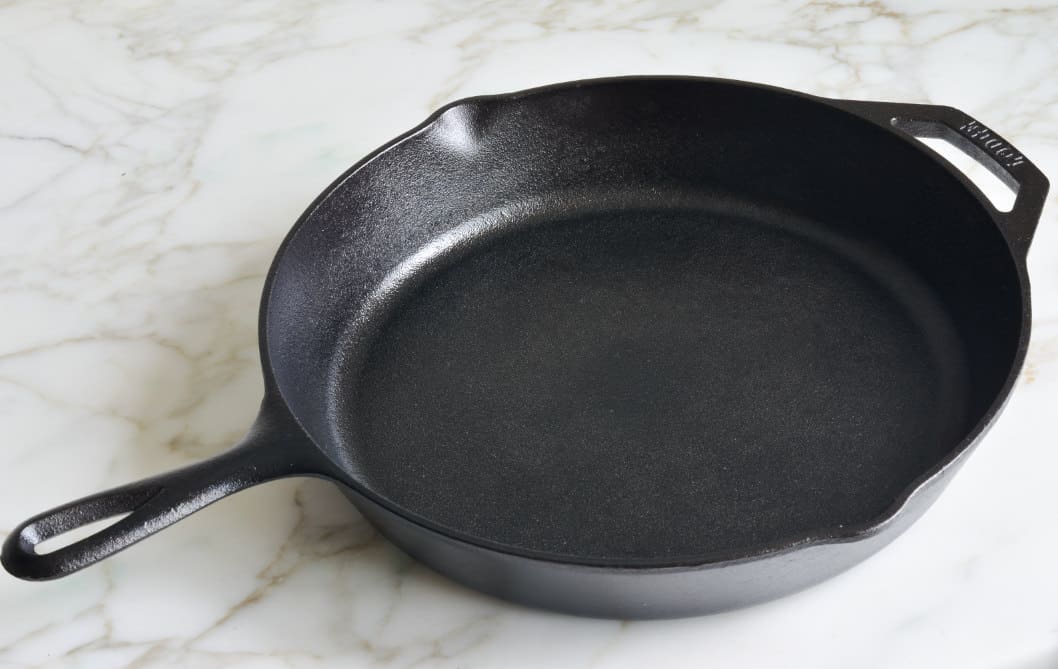
Clean Your Skillet Immediately After Use
To keep the black residue from forming again, make sure to clean off your cast iron skillet as soon as you finished using it.
Most debris came from the leftover food and broken-down fat that cooled off in your cast iron. When you clean the cast iron skillet soon as you are done cooking, the oil and buts of food haven’t set into the skillet yet.
If you want to know how to clean your cast iron skillet, follow these steps:
- Remove the used oil from the pan. You can do this by placing the oil in a small bowl before cleaning the remaining oil with a paper towel. The key to getting your skillet clean is to remove the leftover oil and food as soon as you are done using it. By taking advantage of the still present heat from the stove, the cleaning process is much easier.
- Once you remove the used oil from the pan, the next thing to clean off is the leftover food. You can do this by pouring a cup of warm water and scraping off the bits with a spatula or chainmail sponge.
- After you are done removing the bits of leftover food, you can rinse it off with water. Repeat this process until the skillet is clean.
- Lastly, spread a small amount of either flaxseed oil or canola oil and heat the cast iron in the stove for a minute. The oil will act as a non-stick surface for your pan.
By doing this process, you can maintain a spotless cast iron skillet.
Re-season Your Cast Iron Skillet
Before you re-season your cast iron, you might be asking: What is seasoning?
Since the skillet is built with iron, prolonged exposure to water can cause rusting. By seasoning your pan, you will put a thin sheet of oil in order to eliminate the water exposure.
This protective layer is called patina. By heating the skillet and letting the oil seep into the iron, you can restore the patina. If you own a cast-iron skillet, seasoning is a great way to maintain your pan.
Whenever we use our cast iron skillet, as much as we want it to be cleaned immediately after cooking, the food can sometimes be too distracting.
If you ever left your pan unclean and decided to remove the black residue, some of the patina may be cracked. Don’t worry! Re-seasoning your skillet is an easy task. To do it, you need to:
- Clean off your skillet. To properly clean your cast iron, follow the easy steps above.
- After cleaning, grab a bottle of flaxseed or canola oil. Put a few drops spread it all over the pan with a paper towel.
- After that, you need to put it inside the oven and let it heat up. If you don’t have an oven, leaving the cast iron for a few minutes on top of the stove is a great substitute. he heat helps evaporate any remaining moisture and allows the oil to penetrate the skillet’s surface.
If you want a thick layer of patina, repeat the process 3-5 times. Seasoning your skillet will not only prolong its usability but also provide a non-stick finish.
After reading the process above, you might wonder if simply using your skillet can also season it. The answer is yes. By cleaning and heating the oil in your skillet after usage, you maintain the patina.
Restore Your Skillet
If you are noticing small pecks of rust in your skillet, it’s best to restore it immediately. The rust can come from the moisture from the water, especially if you don’t season it regularly.
By restoring your iron cast skillet, you can use it for a lifetime. This is much more cost-effective than buying aluminum cookware.
In conclusion
Now you know how to properly clean and maintain your cast iron skillet.
With this article, you can prolong the usability of your skillet and cook a lot more meals for your family and loved ones to enjoy.
We hope this article helped you clean off the black residue from your iron cast. If you have more questions, feel free to comment.
Pin Now, Revisit Anytime!


Michael Johnson is the founder of Pan Mastery, Inspired by his blacksmith grandfather’s legacy has a deep appreciation for hand-crafted pots and pans, he provides invaluable guides, reviews, and recipes to enhance your culinary journey.

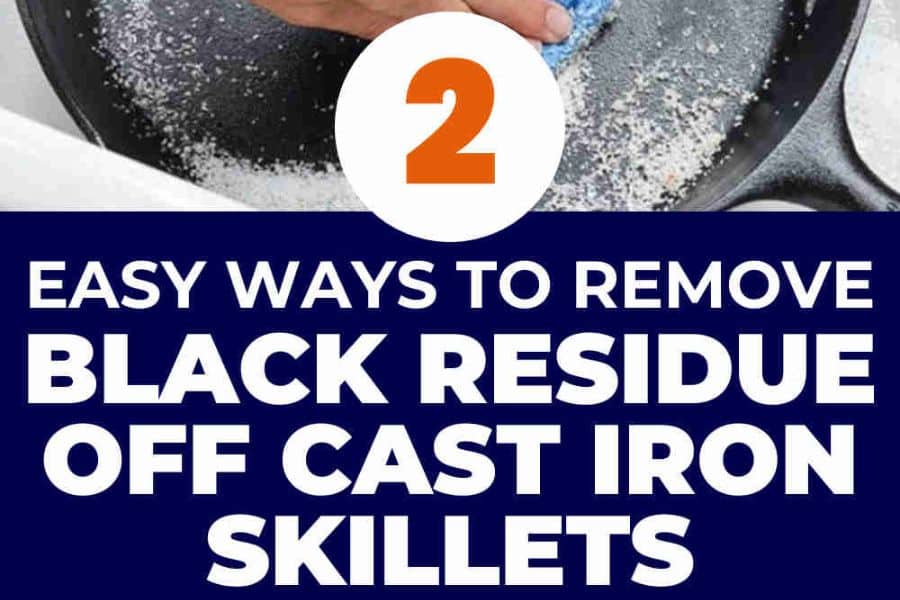
I would like to know what you suggest for restoring a cast iron griddle. I have one that has residue and in places has flaked off. I would like to get it cleaned up so I can re-season it. Thanks for your input!
Hi Laurel,
It depends on the extent of the damage. If the peeling of the frying pan is not severe, you can refer to the steps outlined in these articles:
How To Restore A Rusty Cast Iron Skillet?
5 Tips To Clean Cast Iron Pans
Thank you so much for this post/video! I went to a thrift store and bought a couple that looked decent. I’m a first time owner of a cast iron skillet. Followed your directions and they look new to me! I bought an 8 and a 12 inch. Thanks again. Any easy meals to recommend?
Hi Kimmi,
I’m so glad to hear that you found the post and video helpful, and congratulations on your new cast iron skillets! It’s quite a pleasure to hear that they now look new after you’ve followed the steps. Now, onto your question about easy meals.
Here are some easy and delicious meals you can make using your cast iron skillets.